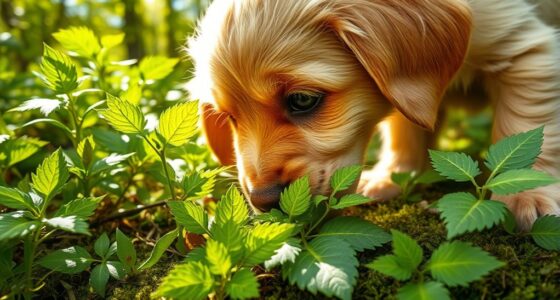For quick, healthy trail treats, you can forage for berries like blueberries or blackberries, ensuring they’re pesticide-free. Grab some fresh herbs such as mint or parsley to add flavor, or small pieces of raw apple and carrot (pits and seeds removed). You can also collect safe grasses or nuts in moderation, depending on your region. Keeping items clean and introducing new snacks gradually keeps your dog safe. Continue exploring these tips to make outdoor adventures even more enjoyable.
Key Takeaways
- Identify safe, edible plants like berries, herbs, and raw vegetables suitable for quick foraging.
- Wash all foraged items thoroughly to remove dirt and potential contaminants before offering to your dog.
- Prepare simple snacks like berry ice cubes, herb-infused yogurt, or chopped fruits in under a minute.
- Use region-appropriate plants, avoiding toxic or polluted areas, and confirm safety with reliable guides or experts.
- Introduce new snacks gradually and in small portions, monitoring your dog’s response for safe enjoyment.

Hiking with your dog offers a great opportunity to enjoy nature and share a healthy snack, but finding safe, natural treats for your furry friend can be a challenge. Instead of relying on store-bought options, you can forage for quick, nutritious snacks that keep your pup energized and satisfied. Foraging snacks are not only convenient but also allow you to incorporate homemade recipes that suit your dog’s dietary needs. However, safety tips are essential to guarantee that what you forage is both safe and beneficial. Always learn to identify edible plants and avoid anything that’s unfamiliar or potentially toxic. Consulting a reliable field guide or local expert can help you distinguish safe options from harmful ones. Remember, just because a plant is edible for humans doesn’t mean it’s safe for dogs, so do thorough research before offering anything to your pet.
Once you’re confident about what’s safe, look for easy-to-forage items such as berries, certain grasses, or even some nuts, depending on your location. Berries like blackberries or blueberries are rich in antioxidants and can be quickly picked in the wild; just make sure they’re free of pesticides and pollutants. You can also gather edible herbs like mint or parsley, which not only freshen your dog’s breath but also add a flavorful touch to homemade treats. For a quick energy boost, some dogs enjoy small pieces of raw apple or carrot, which are usually safe in moderation and can be foraged or bought fresh. Just be cautious to remove any seeds or pits, as these can be toxic.
Creating homemade recipes from your foraged finds is simple and rewarding. Combine berries with a bit of water and freeze into ice cubes for a cooling treat, or blend herbs with plain yogurt for a probiotic-rich snack. Always remember safety tips: avoid plants that grow near polluted areas, and wash all foraged items thoroughly before offering them to your dog. Understanding edible plants is crucial to ensure your foraging is both safe and effective. Keep portion sizes small to prevent digestive upset, and introduce new snacks gradually. If in doubt, stick to well-known safe ingredients and consult your veterinarian if you’re unsure about any foraged item. With a little knowledge and preparation, you can turn a quick forage into a tasty, healthy treat that keeps your dog happy and energized during your outdoor adventures.
Frequently Asked Questions
Are All Wild Plants Safe for Dogs to Eat?
Not all wild plants are safe for your dog to eat, so you should always consider garden safety and plant toxins. Some plants can cause poisoning or digestive issues, even if they look harmless. Before foraging, identify plants carefully and avoid anything unfamiliar. When in doubt, consult a vet or expert to guarantee your dog’s safety. Never assume wild plants are safe just because they’re natural.
How Do I Identify Edible Foraging Plants?
Think of plant identification as your map through a wild garden. You need to learn key features like leaf shape, flower color, and growth habits to guarantee foraging safety. Always use reliable guides or apps, and compare plants carefully. Never eat anything you can’t positively identify, as missteps can be dangerous. Practice with an expert or join foraging groups to sharpen your skills and enjoy safe, tasty discoveries.
Can Foraging Cause Allergies in Dogs?
Foraging can cause allergies in dogs if they encounter plants that trigger sensitivities. You should be aware of foraging risks, such as toxic plants or unfamiliar species. While many foraged plants offer nutritional benefits, like vitamins and fiber, always introduce new foods gradually and observe for allergic reactions. Consulting your vet helps guarantee your dog safely enjoys the nutritional benefits while minimizing allergy risks.
What Precautions Should I Take Before Foraging?
Imagine you’re exploring a lush garden, knowing not every flower is safe. Before foraging, you should identify poisonous plants to avoid harm. Check with local guides or plant identification apps, and start with small quantities to test your dog’s reaction. Always forage in safe, designated areas, and never eat anything you’re unsure about. These steps guarantee your foraging remains safe and enjoyable for your furry friend.
How Often Can My Dog Eat Foraged Snacks?
You should limit your dog’s foraged snacks to a few times a week, considering seasonal variations that affect what’s safe and available. Always prioritize foraging safety by ensuring the plants are non-toxic and free of chemicals. Watch for any signs of allergies or stomach upset. Regular moderation helps prevent overfeeding and keeps your dog healthy, so keep a close eye on their reactions and adjust accordingly.
Conclusion
Now you’re armed with five incredible, mind-blowingly easy trail treats that will turn your dog into a foraging superhero! Imagine their tail wagging so fiercely, they could power a small city, all from the joy of sniffing out these tiny treasures. With just a minute of effort, you’re transforming ordinary walks into epic adventures filled with delicious discoveries. So go ahead—get out there, forage like a pro, and watch your pup become the happiest, most satisfied trail explorer ever!









